Archdeacons of India
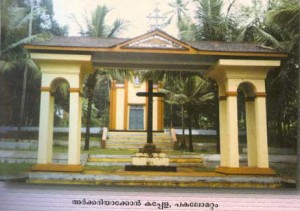 The name ‘Archdeacon’ is commenly pronounced by mistake as ‘Arch-deacon’ but the correct pronounciation is ‘Arkdiyakon’.Inorder to avoid confusion it may be written as ‘Arckadiyakon’. The head of the Indian chuch was held by a preist holding the post of Archdeacon, which in Kerala was called “Arckadiyakon” which means head of one set of people. All the Archdeacons of India, came from only one family, ie. The Pakalomattamfamily. This is one of the rare act of blessing of god, on one family. All historian have agreed that pakalomattam family held the monopoly of this headship of the Church. It was the assigning of the post to the Pakalomattam family by St. Thomas that helped the family to retain the post. The entire Church held the post as one of spiritual holiness and social primacy. It remained as a historical link with the apostolic mission of St. Thomas to India.
The name ‘Archdeacon’ is commenly pronounced by mistake as ‘Arch-deacon’ but the correct pronounciation is ‘Arkdiyakon’.Inorder to avoid confusion it may be written as ‘Arckadiyakon’. The head of the Indian chuch was held by a preist holding the post of Archdeacon, which in Kerala was called “Arckadiyakon” which means head of one set of people. All the Archdeacons of India, came from only one family, ie. The Pakalomattamfamily. This is one of the rare act of blessing of god, on one family. All historian have agreed that pakalomattam family held the monopoly of this headship of the Church. It was the assigning of the post to the Pakalomattam family by St. Thomas that helped the family to retain the post. The entire Church held the post as one of spiritual holiness and social primacy. It remained as a historical link with the apostolic mission of St. Thomas to India.
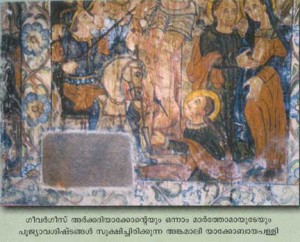 The nepotic succession of Bishophood and priesthood remained with the tradition of succession of the Persian church. It copied the levite priesthood, which worked in the succession principle in the old Testament for 1300 years. This nepotic or patriarchal sucession happened for Archdeacons and Marthoma Metropolitans of Pakalomattam family for 18 centuries. The Nestorians even now practices the patrilined succession. Portugese colonists stopped this among the catholics and ‘Pulikkottil Mar Dionysias’ stopped this in the orthodox side in 1816, with the help of travancore Army and dewan Munroe.
The nepotic succession of Bishophood and priesthood remained with the tradition of succession of the Persian church. It copied the levite priesthood, which worked in the succession principle in the old Testament for 1300 years. This nepotic or patriarchal sucession happened for Archdeacons and Marthoma Metropolitans of Pakalomattam family for 18 centuries. The Nestorians even now practices the patrilined succession. Portugese colonists stopped this among the catholics and ‘Pulikkottil Mar Dionysias’ stopped this in the orthodox side in 1816, with the help of travancore Army and dewan Munroe.
The word nephew(Anantharavan=heir) used in the text shall not be misunderstood as sister’s son, it means only successor. The Brahmin converted Christians followed Patrilineal succession and not the matrilineal succession of Nairs. So also they shunned first cousin marriage which indirectly points to Brahminic origin of Christians. Hence word usually means brother’s son. From Canae Thoma’s time to the 16th century the Persian Patriarch appointed Bishops used to exercise spiritual control of Kerala church on the request of Kerala Christians. These bishops used to ordain priests, gave sacraments, bless churches, bless “Syth”and performed other functions. They were held as honoured guests. The metropolitans used to be known as sitting in the throne of St. Thomas and exercising suzerainty over Indian Church.
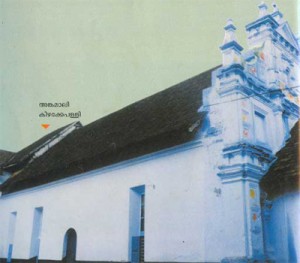 The Metropolitans used to exercise their control over the Church through the Archdeacons. In practical and day to-day functioning of the Church Arch-deacons exercised superintendence. The practical necessity of a native chief was felt by the Persian Bishop as they were ignorant of the language, social and political situation etc. of the place. It came as a hereditary right to Pakalomattam. Down the centuries and over the generations Pakalomattam family produced hundreds of priesta and tens of Bishops. When the oriental missionaries established a new administrative system, they accepted the primacy of the Pakalomattam family. Archdeacon of Kerala Church was not an equal to the Arch-deacons of Europe. He was called prince of believers, Lord of the Christians, and Archdeacon of the whole of India. The Archdeacons were the right arm of the Metropolitan Bishop, and in their absence or vacancy held spiritual control of the Church also. In addition to the rights of Archdeacon in the Persian Church, the Archdeacons of Kerala exercised special powers.
The Metropolitans used to exercise their control over the Church through the Archdeacons. In practical and day to-day functioning of the Church Arch-deacons exercised superintendence. The practical necessity of a native chief was felt by the Persian Bishop as they were ignorant of the language, social and political situation etc. of the place. It came as a hereditary right to Pakalomattam. Down the centuries and over the generations Pakalomattam family produced hundreds of priesta and tens of Bishops. When the oriental missionaries established a new administrative system, they accepted the primacy of the Pakalomattam family. Archdeacon of Kerala Church was not an equal to the Arch-deacons of Europe. He was called prince of believers, Lord of the Christians, and Archdeacon of the whole of India. The Archdeacons were the right arm of the Metropolitan Bishop, and in their absence or vacancy held spiritual control of the Church also. In addition to the rights of Archdeacon in the Persian Church, the Archdeacons of Kerala exercised special powers.
Selection of seminarians, appointing and transferring of priests, exercising temporal powers over the church properties, collecting the levies from the faithful etc. fell within his domain of his powers.
The kings and Princes used to consider him as the chief of Christians. The kings of Cochin used to give royal insignias to the newly elected Archdeacons. Armed Bodyguards used to escort the Archdeacons on their Journeys. On behalf of the Christians he used to parely with the rulers and negotiated with local chieftains. The Persian Patriarch Thimothy (780-826) called him the head of the faithful in India. Unfortunately the names and succession list of Archdeacons prior to the Portugese period is lost to us. After the arrival of the Portugese the records are maintained. In 1502 Mar Yohannan Metropolitan appointed the famous Geevarghese Archdeacon from pakalomattam family. In 1509 an archdeacon called Itty Kurian of Pakalomattam family is cited. He mediated between the two conciliation is available in the Pothanikara family of Kothamangalam. He belonged to the root family of Pakalomattam. Two other Archdeacons called Chandy and Geevarghese of Pakalomattam are referred to but biographical details are not known. Only thing known is that they belonged to Pakalomattam.
Archdeacon Geevarghese of Christ (died 1585 AD)
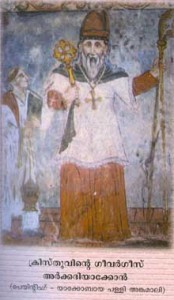 One of the most famous Archdeacons of history is this Geevarghese. He was a Biblical expert and a master of syriac language and literature. He was considered a holy person but extremely efficient in administration. He was appointed Bishop of Palayur, but due to the machinations of the Portugese he could not be ordained. He was contemporary to Bishop Abraham of Persia who lived in Ankamali. He is credited with the new construction of Ankamali church. He is buried in the Jacobite church in Ankamali. His brother Yohannan was Archdeacon (1585 – 93). Another brother Jacob? Became Archdeacon in 1596. Some say one was nephew.
One of the most famous Archdeacons of history is this Geevarghese. He was a Biblical expert and a master of syriac language and literature. He was considered a holy person but extremely efficient in administration. He was appointed Bishop of Palayur, but due to the machinations of the Portugese he could not be ordained. He was contemporary to Bishop Abraham of Persia who lived in Ankamali. He is credited with the new construction of Ankamali church. He is buried in the Jacobite church in Ankamali. His brother Yohannan was Archdeacon (1585 – 93). Another brother Jacob? Became Archdeacon in 1596. Some say one was nephew.
Archdeacon Geevarghese of the cross
He was the son of the elder brother of Archdeacon of the Christ. By the last year of Bishop Abraham, he became the Archdeacon. After the death of Persian Bishop Abraham in 1597, he led the Indian church. He led the church amidst Portuguese intervention. The synod of Diamper 1599 was held during his time. In 1601 Francis Roz became Bishop. In Beginning there was cordiality. But the deliberate degradation of Ankamali and the inertia of Bishop Roz frustrated him. When the Archdeacon protested, Roz ex-communicated him. In 1615 Bishop and archdeacon reconciled each other, but again fell out later. The next Bishop Britto also did not recongnise the Archdeacon’s status. He died in 1637 AD. He suffered much to preserve the status of the Archdeacons. He led the church in a period of severe stress and held it together. When in 20th century an election was done to select 20 great men of Kerala’s history, he was one of the twenty who was selected. After his time and his brother’s time the root family of Pakalomattam became heirless. The only son shifted residence to Alappatt house. Archdeacon Geevarghese is believed to have been buried in the forefront of Pakalomattam Tharavadu.
Archdeacon Thomas
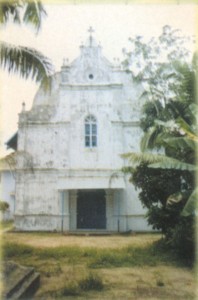 He came from Vadakkedathu family and succeeded Archdeacon geevarghese of the cross. Bishop Garcia who succeeded Britto did not recognize the powers of the Archdeacon. The right widened and St. Thomas Christians started looking towards Persia for a Bishop to regive their powers. At this occasion Bishop Cyril mar Ahatullah Ibin Isa came to Mylapur and Kochi. Orthodox call him Ahatullah Partriarch. Catholics call him as Bishop of Aleppo in Palestine. He was not permitted to land in Mattancherry. Orthodox people think that he was drowned by the Portugese in Kochi Backwaters. Catholics say that Portugese carried him to Lisbon and he died in Europe. The kidnap of the Bishop enraged the Kerala Christians. They came to Mattancherry coonen cross on January 3-1653 and made the famous Pledge of the coonen cross. Expecting that he will be ordained Bishop, he was declared Bishop Marthoma I on June 1st 1653. all reconciliations failed between Bishop and Archdeacon.
He came from Vadakkedathu family and succeeded Archdeacon geevarghese of the cross. Bishop Garcia who succeeded Britto did not recognize the powers of the Archdeacon. The right widened and St. Thomas Christians started looking towards Persia for a Bishop to regive their powers. At this occasion Bishop Cyril mar Ahatullah Ibin Isa came to Mylapur and Kochi. Orthodox call him Ahatullah Partriarch. Catholics call him as Bishop of Aleppo in Palestine. He was not permitted to land in Mattancherry. Orthodox people think that he was drowned by the Portugese in Kochi Backwaters. Catholics say that Portugese carried him to Lisbon and he died in Europe. The kidnap of the Bishop enraged the Kerala Christians. They came to Mattancherry coonen cross on January 3-1653 and made the famous Pledge of the coonen cross. Expecting that he will be ordained Bishop, he was declared Bishop Marthoma I on June 1st 1653. all reconciliations failed between Bishop and Archdeacon.
In 1661 Sebestiani became Bishop. Dutch conquered Kochi in 1663. Sebastiani fled Kerala. But before he left, he ordained a relative of Marthoma I belongs to Pakalomattam family named Chandy as Alexander De Campo, as Bishop. Marthoma I was excommunicated by the Bishop.
Udayamperoor Synod church
 In 1665 Mar Gregorios Abdul Galeel from Antioch came and ordained Marthoma I as Bishop. Till that time he carried an Administraion with the public acceptance of the faithful. The Kerala church history took a new turn. On 1670 April 24, Marthoma I died. He was one of the ferocious fighters of Kerala church. If the Portugese dealt the Archdeacons with little more of tact and compassion and the Roman Catholic Church accepted the Syrian traditions, the unfortunate division of the Christian Church would have been avoided. The Portugese military might could not humble the Archdeacon Thomas/Marthoma I
In 1665 Mar Gregorios Abdul Galeel from Antioch came and ordained Marthoma I as Bishop. Till that time he carried an Administraion with the public acceptance of the faithful. The Kerala church history took a new turn. On 1670 April 24, Marthoma I died. He was one of the ferocious fighters of Kerala church. If the Portugese dealt the Archdeacons with little more of tact and compassion and the Roman Catholic Church accepted the Syrian traditions, the unfortunate division of the Christian Church would have been avoided. The Portugese military might could not humble the Archdeacon Thomas/Marthoma I
‘Thalam’ used by Archdeacons for holy qurbana
Archdeacon Kunju Mathai
Archbishop Garcia disregarded Archdeacon Thomas and appointed Geevarghese Archdeacon’s brother’s son Kunju Mathai as Archdeacon. He could not function due to the popularity of Thomas Archdeacon. He stayed in Kochi for two years and then came to Kaduthuruthy and later joined with Marthoma Bishop.
Archdeacon Mathai
Bishop Alexander De Campo, appointed his nephew as Archdeacon in 1678. Bishop Alexander De Campo wanted Arch deacon Mathai to succeed him. But Bishop Sebastiani obstructed this. Bishop Raphael who succeeded Alexander De Campo died in 1695. During the six years vacancy, archdeacon Mathai ruled the Church as Archdeacon Administrator. After his death the post of Archdeacon ended permanently.
End of Archdeacons
As native Bishops came after the ordination of Marthoma I, the Archdeacon post became superfluous. Archdeacon was a minor post in the European tradition. Hence with Latinisation the Post of Archdeacon was overshadowed. In the Antiochian tradition Cor Episcopa, Rmban etc. were important. The Bishop Marthoma I and successors held the Pakalomattam leadership of the church till 1817. All Marthoma Metropolitans were from the Pakalomattam family. The Palliyogam and democratic church administration, the speciality of Kerala church came out of this tradition of Archdeacons.